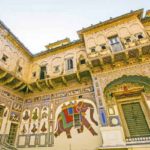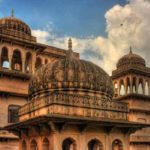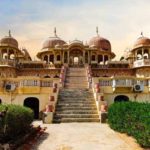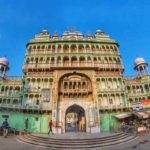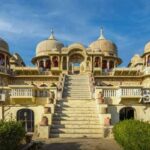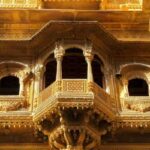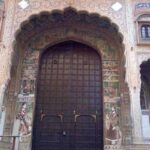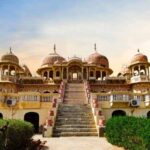Mandawa Travel Information, located in the Shekhawati region of Rajasthan, India, is a mesmerizing destination that boasts a rich cultural heritage and architectural marvels. This small town, often referred to as an open-air art gallery, attracts tourists from around the world with its stunning havelis (mansions) adorned with intricate frescoes and vibrant murals.
Mandawa’s history can be traced back to the 18th century when it served as an important trading post on the ancient Silk Route. The prosperous merchants and traders of Mandawa constructed magnificent havelis as a symbol of their wealth and status. These havelis, with their elaborate facades and detailed artwork, have now become the main attractions for tourists.
Wandering through the narrow streets of Mandawa feels like stepping back in time. Every corner reveals a new masterpiece, depicting scenes from mythology, folk tales, and daily life. Some of the renowned havelis include the Murmuria Haveli, Goenka Haveli, and Hanuman Prasad Goenka Haveli. These architectural wonders showcase a fusion of Rajput and Mughal styles, with intricate carvings, ornate balconies, and charming courtyards.
Apart from havelis, Mandawa is also home to ancient temples that add to its religious and historical significance. The Mandawa Fort, a grand structure located in the heart of the town, offers panoramic views of the surrounding landscape. Exploring its numerous rooms and corridors provides a glimpse into the regal lifestyle of the past.
For art enthusiasts, Mandawa Tour hosts an annual art festival known as the Mandawa Art Fair. This vibrant event brings together artists, musicians, and performers from different parts of Rajasthan, showcasing their talents and preserving the region’s cultural heritage.
The town’s vibrant atmosphere, coupled with its rich history and artistic splendor, makes it an ideal destination for heritage and culture enthusiasts. Visitors can immerse themselves in the charm of Mandawa by taking a leisurely stroll through its streets, marveling at the awe-inspiring artwork, and interacting with the friendly locals.
To enhance the experience, tourists can also indulge in Rajasthani cuisine, known for its flavorsome curries and traditional sweets. Shopping enthusiasts can explore the local markets for intricately designed handicrafts, textiles, and traditional jewelry.
In conclusion, Mandawa is a hidden gem that showcases the architectural brilliance and cultural heritage of Rajasthan. With its stunning havelis, ancient temples, and lively festivals, this town offers a captivating glimpse into the past. A visit to Mandawa promises an unforgettable journey through history, art, and tradition.
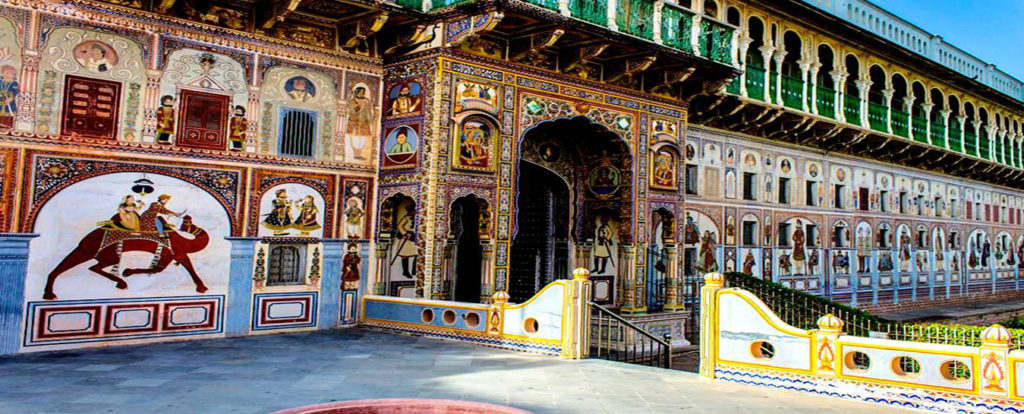
History of Mandawa
The history of Mandawa dates back to the 18th century when it was established as a prosperous trading post along the ancient Silk Route. It was founded by the wealthy merchant clan of Rajputs known as the Shekhawat Rajputs. These merchants, who had amassed considerable wealth through trade, constructed magnificent havelis (mansions) as a display of their affluence and social status Rajasthan Tourism.
Mandawa served as a vital stopover for caravan traders traveling between China and the ports of the Indian subcontinent. The town flourished economically due to its strategic location, attracting merchants from different regions who brought with them a diverse range of goods and cultures.
The havelis of Mandawa were built during the 18th and 19th centuries. These opulent mansions were not just residences but also served as centers for cultural and social gatherings. The merchants commissioned local artists to adorn the walls and ceilings of the havelis with intricate frescoes and murals. These paintings depicted various themes, including mythological scenes, historical events, religious motifs, and glimpses of everyday life.
Over time, as the Silk Route lost its significance and trade patterns shifted, Mandawa’s prosperity declined. Many of the wealthy merchant families migrated to larger cities, leaving their havelis behind. These once-magnificent structures gradually fell into neglect and were at risk of being forgotten.
However, in recent years, there has been a renewed interest in preserving and showcasing the heritage of Mandawa. Efforts have been made to restore the havelis and revive the town’s cultural significance. The intricate artwork and architectural beauty of the havelis have attracted tourists and art enthusiasts from around the world.
Today, Mandawa has become a popular tourist destination, known for its well-preserved havelis and rich cultural heritage. It offers visitors a unique opportunity to step back in time and experience the grandeur of Rajasthan’s past. The town’s historical significance, coupled with its artistic marvels, has earned it the reputation of being an open-air art gallery.
Mandawa’s history is a testament to the entrepreneurial spirit and artistic patronage of the Shekhawat Rajputs. It stands as a living testament to the legacy of the merchants who once thrived in this vibrant trading post along the Silk Route.
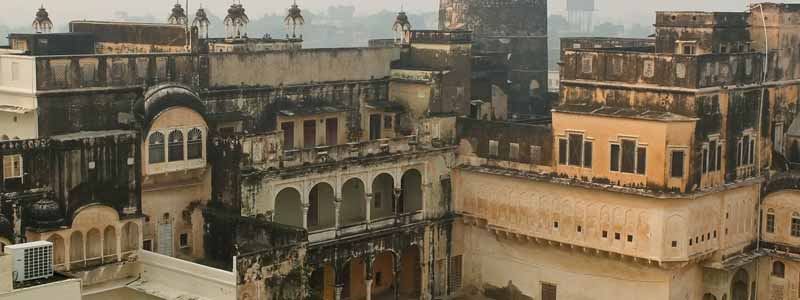
Places to Visit in Mandawa
Mandawa, a town in the Shekhawati region of Rajasthan, India, offers a plethora of attractions for visitors to explore. Here are some of the must-visit places in Mandawa:
Mandawa Fort: The imposing Mandawa Fort, also known as Castle Mandawa, is a major landmark in the town. This magnificent fort showcases a fusion of Rajput and Mughal architectural styles. Visitors can explore the various sections of the fort, including its grand courtyards, beautiful rooms, and intricate frescoes. The fort also offers panoramic views of the surrounding countryside.
Havelis: Mandawa is famous for its beautifully painted havelis that exhibit exquisite frescoes and intricate artwork. Some notable havelis to visit include the Murmuria Haveli, Goenka Haveli, Hanuman Prasad Goenka Haveli, and Jhunjhunwala Haveli. These havelis showcase the wealth and artistic patronage of the merchants of Mandawa.
Mandawa Market: A visit to Mandawa would be incomplete without exploring the bustling local market. The market is a treasure trove of traditional Rajasthani handicrafts, textiles, jewelry, and artwork. It’s a great place to shop for souvenirs and immerse yourself in the local culture.
Mandawa Art Gallery: For art enthusiasts, the Mandawa Art Gallery is a must-visit. It houses a collection of contemporary and traditional artworks from renowned artists of the region. The gallery provides insights into the rich artistic heritage of Mandawa and Rajasthan as a whole.
Temples: Mandawa is home to several ancient temples that hold religious and historical significance. The popular temples in the area include the Harlalka Well, Mandawa Hanuman Temple, and Shri Raghunath Ji Temple. These temples showcase intricate architectural details and are important pilgrimage sites for locals.
Saraf Haveli Museum: The Saraf Haveli Museum is a unique attraction that offers a glimpse into the opulent lifestyle of the wealthy merchants of Mandawa. It houses a collection of artifacts, including traditional costumes, antique furniture, and vintage photographs, providing a glimpse into the town’s rich history.
These are just a few of the many attractions that Mandawa has to offer. Exploring the town’s havelis, forts, temples, and markets will give you a deeper understanding of its rich history, architectural beauty, and vibrant culture.
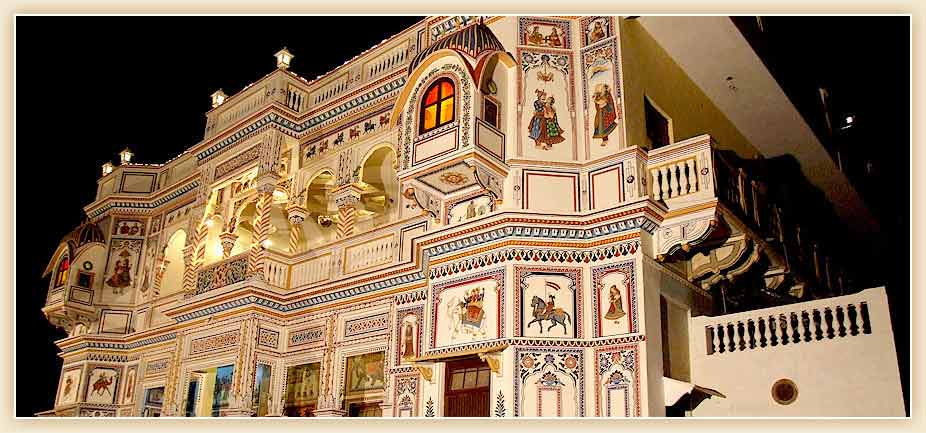
Famous Shopping Markets in Mandawa
Mandawa, known for its rich cultural heritage and vibrant art scene, offers several shopping markets where visitors can indulge in traditional Rajasthani shopping. Here are some of the famous shopping markets in Mandawa:
Mandawa Bazaar: The bustling Mandawa Bazaar is the main market in town and a hub for shopping. Here, you can find a wide array of traditional Rajasthani handicrafts, textiles, and artwork. From colorful turbans, embroidered fabrics, and tie-dye clothing to intricately designed jewelry and leather goods, the market offers a delightful shopping experience.
Murmuria Haveli Market: Located near the Murmuria Haveli, this market is known for its unique collection of handicrafts and artwork. You can find beautiful hand-painted pottery, wooden crafts, lac bangles, and traditional Rajasthani paintings known as “Phad” and “Miniature” paintings. The market offers a chance to buy authentic Rajasthani souvenirs directly from local artisans.
Saraf Haveli Market: Situated near the Saraf Haveli Museum, this market is known for its antique and vintage items. Here, you can browse through a variety of old coins, jewelry, artifacts, and traditional Rajasthani textiles. It’s a great place to find unique and collectible items that reflect the rich history of Mandawa.
Raghunathgarh Market: Located in the nearby village of Raghunathgarh, this market is famous for its colorful and intricate Rajasthani textiles. You can find a range of embroidered fabrics, tie-dye textiles, bandhani (tie-dye) sarees, and vibrant turbans. The market is a haven for textile enthusiasts looking to add a touch of Rajasthan to their wardrobe.
Mandawa Art Gallery Market: Adjacent to the Mandawa Art Gallery, this market offers a variety of art-related items. You can find miniature paintings, traditional art supplies, and other art forms unique to the region. It’s an ideal place for art lovers and collectors looking to take home a piece of Mandawa’s artistic heritage.
While exploring these markets, it’s important to engage in bargaining to get the best deals. The local shopkeepers are generally friendly and willing to negotiate prices. Remember to take your time to explore the stalls and compare prices before making a purchase.
Shopping in Mandawa’s markets provides a glimpse into the vibrant art and craft traditions of Rajasthan. It’s an opportunity to support local artisans and take home unique souvenirs that reflect the cultural richness of the region.
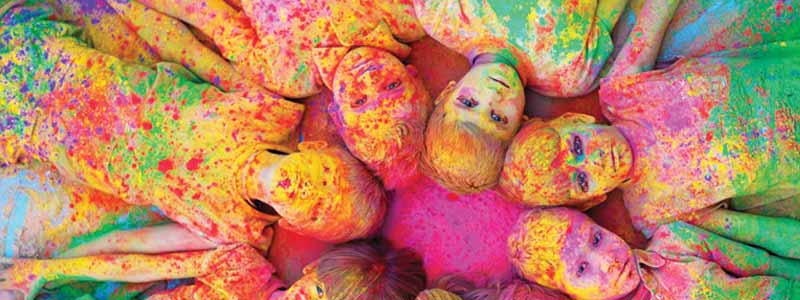
Festivals of Mandawa
Mandawa, located in the Shekhawati region of Rajasthan, India, celebrates various festivals throughout the year, showcasing the rich cultural heritage of the region. Here are some of the festivals celebrated in Mandawa:
Teej Festival: Teej is a prominent festival celebrated by women in Mandawa and Rajasthan. It usually falls in the month of August and marks the onset of the monsoon season. Women dress up in traditional attire, adorn themselves with henna, and participate in processions and cultural performances. The festival is dedicated to the goddess Parvati and celebrates marital bliss and prosperity.
Gangaur Festival: Gangaur is a colorful and vibrant festival celebrated by women in Mandawa and across Rajasthan. It takes place in the months of March and April and lasts for several days. Women worship the goddess Gauri (an incarnation of Parvati) for the well-being of their husbands. The festival involves singing and dancing, processions of beautifully adorned idols, and traditional rituals.
Diwali: Diwali, also known as the Festival of Lights, is widely celebrated in Mandawa as it is throughout India. It usually falls in October or November and symbolizes the victory of light over darkness and good over evil. People decorate their homes with earthen lamps (diyas) and colorful rangoli patterns. Fireworks light up the sky, and families come together to exchange sweets and gifts.
Holi: Holi, the festival of colors, is another vibrant celebration in Mandawa. It usually takes place in March and marks the arrival of spring. People engage in playful water and color fights, smearing each other with colored powders and spraying water. Holi in Mandawa is a lively affair, filled with music, dance, and joyous celebrations.
Mandawa Art Festival: The Mandawa Art Festival is an annual event that celebrates the art and culture of the region. It brings together artists, musicians, and performers from different parts of Rajasthan. The festival showcases traditional music and dance performances, art exhibitions, craft demonstrations, and cultural programs. It provides a platform for artists to showcase their talent and promotes the cultural heritage of Mandawa.
These festivals are a significant part of Mandawa’s cultural fabric and provide a glimpse into the vibrant traditions and rituals of Rajasthan. Visitors during these festive times can witness the town come alive with colors, music, and cultural fervor, creating an unforgettable experience.
Best Time to Visit Mandawa
The best time to visit Mandawa is during the winter months, from October to March, when the weather is pleasant and comfortable. Here’s a breakdown of the seasons in Mandawa:
Winter (October to March): Winter is the peak tourist season in Mandawa due to the pleasant weather. The temperature during this time ranges from 10°C to 25°C (50°F to 77°F). The days are sunny and pleasant, making it ideal for exploring the town’s attractions, including the havelis and forts. The evenings can get chilly, so it’s advisable to carry some warm clothing.
Summer (April to June): Summers in Mandawa are scorching hot, with temperatures ranging from 30°C to 45°C (86°F to 113°F). The months of May and June can be particularly intense, with temperatures soaring. It’s not the most comfortable time to visit Mandawa, as the heat can be overwhelming, especially for outdoor activities. If you plan to visit during summer, it’s essential to stay hydrated and take necessary precautions.
Monsoon (July to September): Mandawa experiences monsoon from July to September, with sporadic rainfall. While the rainfall brings relief from the heat, it can make sightseeing challenging due to wet and muddy conditions. However, if you enjoy the lush greenery and a quieter atmosphere, visiting Mandawa during the monsoon can be a unique experience.
Considering the weather conditions, the winter season is the most favorable time to visit Mandawa. The pleasant temperatures allow you to explore the town comfortably and enjoy outdoor activities. Additionally, during winter, Mandawa hosts various festivals like Teej and Diwali, adding to the cultural vibrancy of the region.
It’s worth noting that Mandawa can be crowded with tourists during the peak winter season. If you prefer a quieter experience, consider visiting during the shoulder months of October and March when the weather is still pleasant, and the crowds are relatively thinner.
Ultimately, the choice of the best time to visit Mandawa depends on your preferences and tolerance to weather conditions.
How to Reach Mandawa
Mandawa, located in the Shekhawati region of Rajasthan, India, is well-connected to major cities and towns in the state. Here are the different modes of transportation to reach Mandawa:
By Air: The nearest airport to Mandawa is Jaipur International Airport, which is approximately 168 kilometers away. From Jaipur, you can hire a taxi or take a bus to reach Mandawa. The airport is well-connected to major cities in India and operates both domestic and international flights.
By Train: The closest railway station to Mandawa is Jhunjhunu Railway Station, situated around 27 kilometers away. It is well-connected to major cities like Delhi, Jaipur, and Bikaner. From the railway station, you can hire a taxi or take a local bus to reach Mandawa. Alternatively, you can also take a train to Jaipur or Bikaner, which have more frequent train services, and then proceed to Mandawa by road.
By Road: Mandawa is easily accessible by road, and several state highways connect it to nearby cities and towns. You can hire a taxi or take a bus from cities like Jaipur, Bikaner, and Delhi to reach Mandawa. The roads are well-maintained, and the journey offers scenic views of the countryside.
- From Jaipur: Mandawa is approximately 190 kilometers from Jaipur, and it takes around 4-5 hours by road. You can take the NH11 and SH8 routes to reach Mandawa.
- From Delhi: Mandawa is approximately 250 kilometers from Delhi, and it takes around 5-6 hours by road. You can take the NH48 route via Bahadurgarh, Rohtak, and Jhunjhunu to reach Mandawa.
Local transportation within Mandawa is mainly by auto-rickshaws and cycle rickshaws, which are readily available for short distances. It’s advisable to have a local map or navigation assistance to locate specific havelis and attractions within the town.
Remember to check for any travel advisories, weather conditions, and road conditions before planning your trip to Mandawa.

